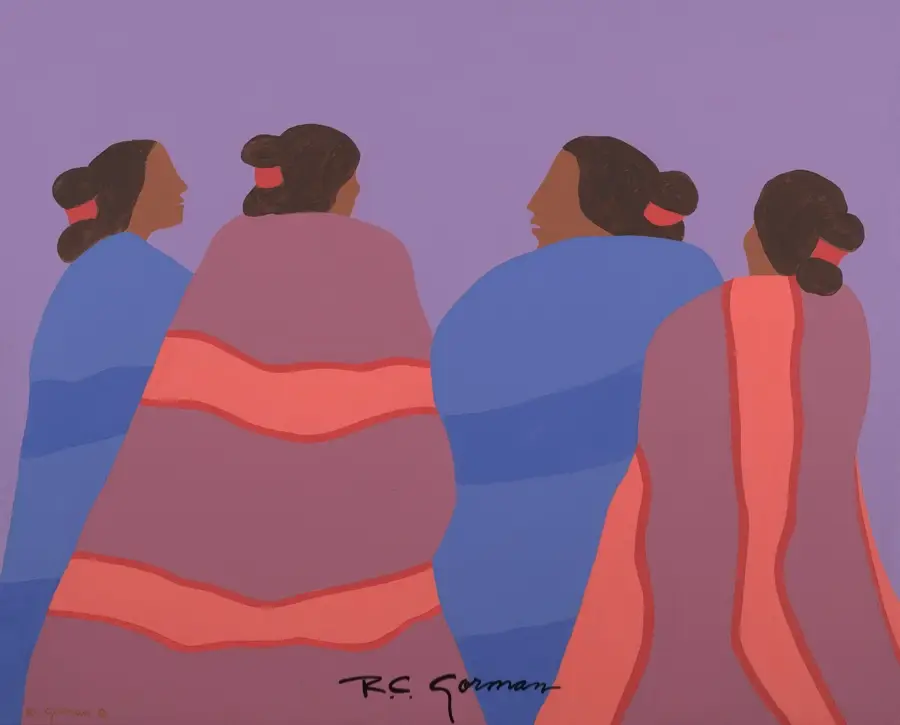Free Shipping! - Order $99 or More (excludes framed items)

R.C. Gorman’s Mediums
R.C. Gorman worked with a variety of different art mediums. As you browse through the R.C. Gorman Navajo Gallery Shop, you may want to refer back to this page where you can read and learn about the various art mediums Gorman used.

Original Lithographs & Limited Editions:
R.C. Gorman’s original lithographs are hand signed and numbered. Unlike offset lithography where the image is “offset” from a rubber blanket, R.C. Gorman’s original lithographs were pulled directly from the artist’s stone drawings.
Each pulled impression, with its slight variation of color and alignment, is considered an original. All of Gorman’s original lithographs were conceived and executed by the artist on flat stones or plates then they were printed by either the artist himself or a collaborating printer.
Each finished lithograph consists of several layers of carefully aligned colors and shapes that were sequentially pulled from separate stone drawings. In his lithographs, R.C. Gorman was well-known for his use of the “Rainbow Roll,” which is the smooth gradation of color that often appears in the backgrounds of his pieces.
Original Serigraphs:
R.C. Gorman’s original serigraphs are hand signed and numbered. Serigraphy, also known as silkscreen printing, is a stenciling technique in which the artist squeegees ink through a partially blocked screen. The artist builds up the final image by carefully aligning the screens and squeegeeing one layer of color at a time. This printmaking process was most famously reintroduced to the art world by Andy Warhol, a close friend of R.C. Gorman.
Original Woodblock Prints:
R.C. Gorman’s original woodblock prints, seen below, are hand signed and numbered. The woodcut printmaking process derives from Egyptian and Chinese traditions. Using this process, the artist, sometimes with the help of a skilled craftsman, cuts into a block of wood to create the image in relief. R.C. Gorman finished several woodblock prints while traveling in Japan and studying under printmaking masters in Tokyo.
Original Etchings:
R.C. Gorman’s original etchings are hand signed and numbered. With the intaglio process, the artist covers a copper or zinc metal plate with an acid-resistant ground. The artist then cuts into the ground with a needle, leaving an exposed section of the metal. When covered with acid, the exposed areas are etched permanently into the surface of the metal. Depending on the length of exposure and the temperature, the acid bites create a variety of depths on the plate. The plate is then inked, covered with a moistened paper, and run through the press. Because the paper is damp, it fits into the various depths of the plate and grabs the ink. Often, the topography of the metal plate is visible on the surface of the dried paper.
Original Papercast:
For Gorman to create a papercast, he must first sculpt it in clay. He adds clay to a large block building up his design. Liquid rubber is poured over this to create a mould. When the rubber sets, paper pulp is cast into the rubber mould occupying the space the clay once had. The water is forced out and the piece is left to dry for a week before being removed from the mould. Once fully dried, Gorman inspects, signs, and numbers each papercast.
Original Oil Pastel Drawings and Acrylic Paintings:
R.C. Gorman’s original oil pastel drawings and acrylic paintings are one-of-a-kind artworks. Working from live models, the artist uses quick, suggestive lines to capture the spirit of the model’s presence in each piece.
Giclees:
Made using a special process, our Giclees are an affordable alternative to R.C. Gorman originals. Our giclees are the highest quality reproductions of R.C. Gorman’s original artwork available anywhere making it very difficult to tell the difference between the Giclees and the originals. Please be aware of cheaply priced counterfeit “knock offs” available on the internet. You can be assured that when you purchase from the R.C. Gorman Navajo Gallery, you are buying from the “Only Official Authorized Source” for art work from the R.C. Gorman Estate.
All edges are hand-torn to remain consistent with the artist’s aesthetic intent. They are printed on 100% cotton rag paper with 100-150 year archival ink so that they can be enjoyed for years to come.
The cotton paper has a much longer life span than commonly found with cheaper printing papers. Although more expensive, the long fibre strands of the cotton give the paper the strength to withstand rougher handling without easily tearing. R.C. Gorman Navajo Gallery Giclees can better withstand the changes in humidity and temperature.
Giclees accurately capture the colors and intent of the original art as closely as possible that not only can last for years …it can actually outlast the original!









